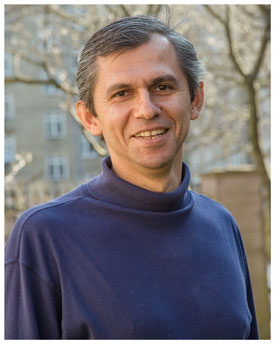The Carlsberg foundation supports the search for hidden particles with a grant of 4.4 million DKK
Oleg Ruchayskiy, lector in the research group Experimental Subatomic Physics at the Niels Bohr Institute, University of Copenhagen receives grant of 4.4 million DKK from the Carlsberg Foundation for the project: Microphysics of the Universe. The project centers on research in dark matter, the origin of matter and searching for new subatomic particles.
Oleg Ruchayskiy, formerly employed at CERN, the European Organization for Nuclear Research, and in the Institute for Theoretical Physics, EPFL, Lausanne, Switzerland, came to a position in Phenomenology at the Niels Bohr Institute in 2016. The focus of his research is primarily particle physics, astrophysics and cosmology in the early universe. Phenomenology in physics attempts to bridge the gap between theoretical particle physics and the high energy experiments carried out in accelerators. Hypotheses are tested against the results in the experiments.
Oleg Ruchayskiy graduated from Moscow Institute of Physics and Technology (Moscow, Russia). Later, in 2003, he received his Ph.d. at the University of Chicago in the USA. After his Ph.d. he travelled to France, where he had positions as both William Hodge Fellow and Marie Curie Fellow at the Institute for advanced Studies (IHES) in Paris.
Research in subatomic physics is far from over
We have had great success in researching subatomic physics and for the first time in nearly a century, we are in a situation where all the particles earlier predicted to be in the Standard Model of particle physics have now been found experimentally. The latest breakthrough in the research of particle physics was the discovery of the Higgs particle in July 2012, the last and rather evasive piece in the puzzle. The discovery of the Higgs particle was crucial for the understanding of how elementary particles obtain mass. It is, however, not the end of this field of research, but rather the beginning of a new era, as it is clear now that some phenomena in particle physics and cosmology lack their understanding within the framework of the Standard Model of particle physics.
The new particles
Dark matter is one of these phenomena. We know that only 4-5 % of the matter in the universe can be observed directly and 23-25 % is presumed to be invisible dark matter. We know it is there through its gravity pull exerted on the visible matter (the remaining app. 70 % is presumed to consist of dark energy). Furthermore, there are three types of neutrinos, and the fact that they have mass and can turn into one another (Nobel prize of 2015) is an indication that additional particles, the so-called sterile neutrino, should exist. These particles are believed to be able to contribute to the explanation of what dark matter really is, and also explain the origin of matter-antimatter asymmetry of the Universe.
Oleg Ruchayskiy is a co-author and a contributor to the new experimental proposal called SHiP – search for hidden particles. The quest for the hidden particles, mentioned above, is the scientific goal for the SHiP experiment, currently under development in CERN.
The 4.4 million DKK from the Carlsberg Foundation’s Distinguished Associate Professor Fellowship will be used for the employment of two postdocs and a PhD student.
Read about SHiP here: https://cds.cern.ch/journal/CERNBulletin/2015/28/News%20Articles/

Oleg Ruchayskiy, Associate professor, Experimental Particle Physics, Niels Bohr Institute, University of Copenhagen, Blegdamsvej 17, 2100 København Ø, Email: Oleg.Ruchayskiy@nbi.ku.dk Telefon: +45 35 33 33 80
Topics
See also:
Contact
Oleg Ruchayskiy, Associate professor, Experimental Particle Physics, Niels Bohr Institute, University of Copenhagen, Blegdamsvej 17, 2100 København Ø, Email: Oleg.Ruchayskiy@nbi.ku.dk Telefon: +45 35 33 33 80

